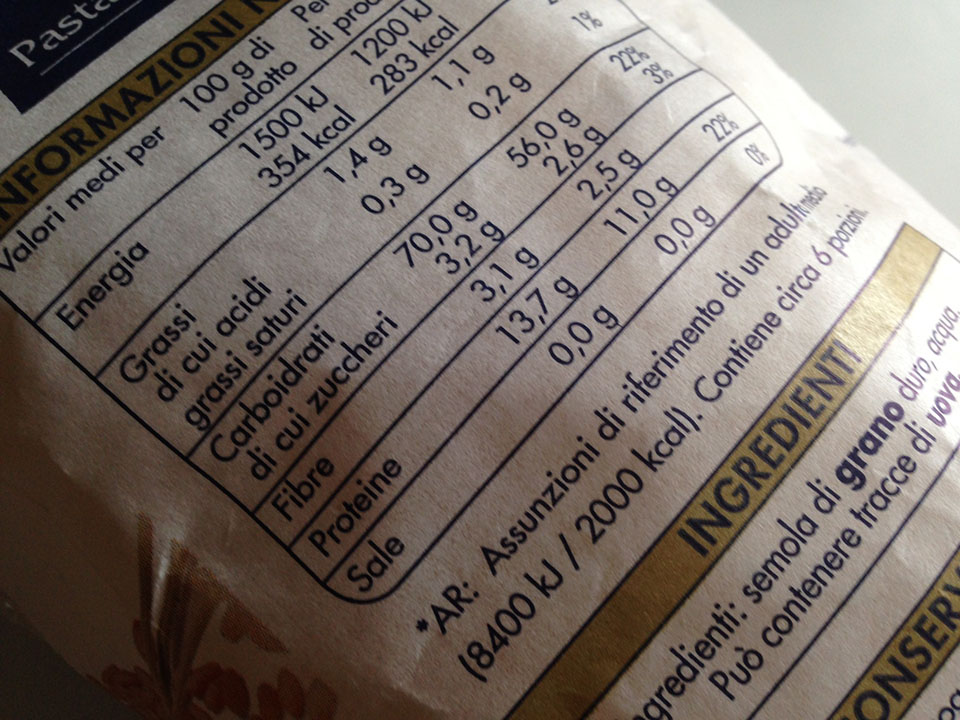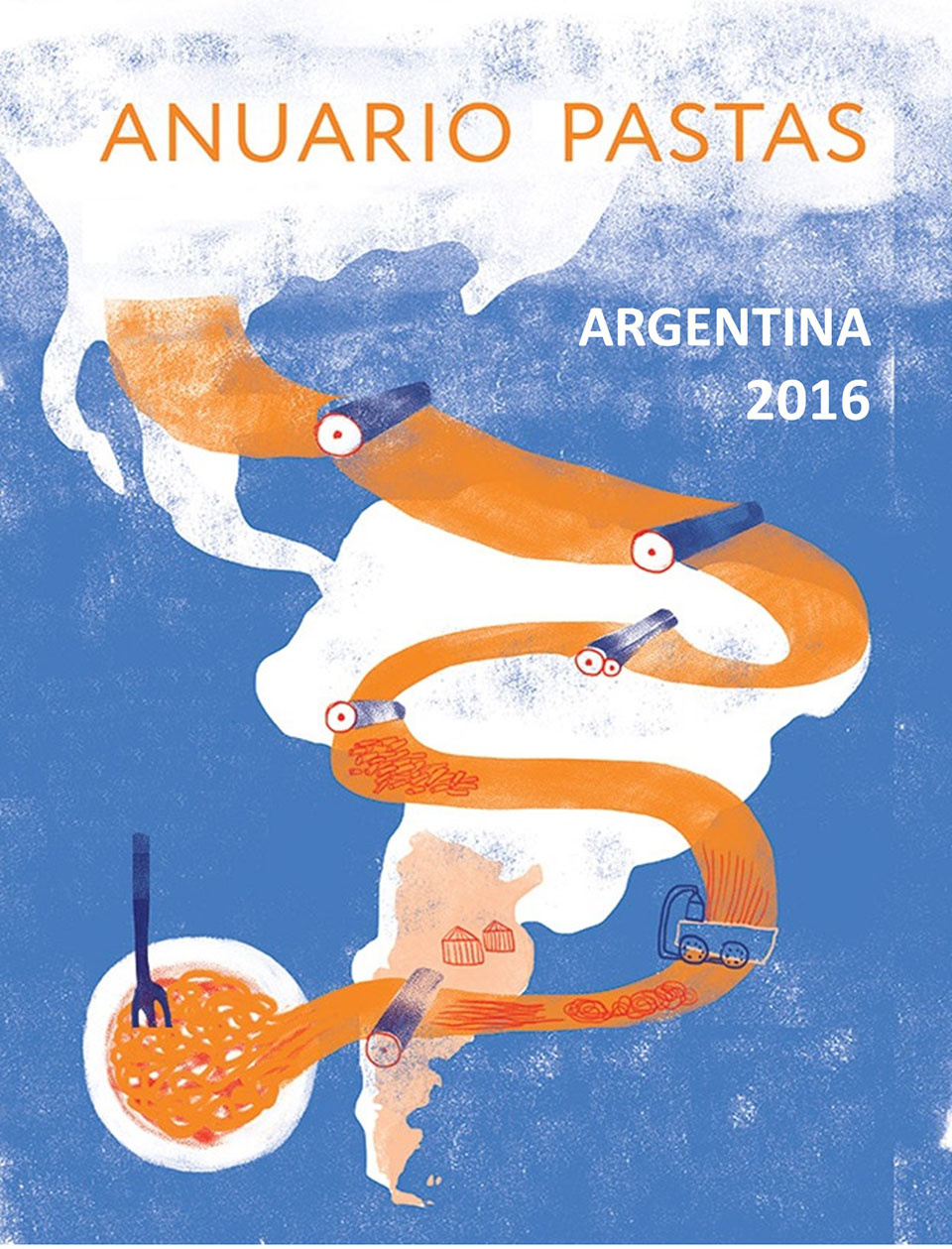
Food labelling: status report on obligations of pasta manufacturers
11 October 2016As of December 13, 2016, the measures involving nutrition labelling will be fully in force in all EU countries.
by Lino Vicini
As is known, regulations involving the labelling of food products were standardized within the European Union by Regulation (EU) No. 1169/2011.
This regulation marked the end of the evolutionary process begun back in 1979 with the European parliament’s passing of the first “horizontal” legislation regarding food labelling (Directive 78/112/EC).
It should be stressed that Regulation 1169/2011 not only consolidates and updates legislation regarding food labelling in general, but also that involving nutrition labelling.
Through nutrition labelling, consumers must have access to clear and coherent information that is adequately substantiated.
This requirement is of particular interest to the European legislature which, at the time, examined this issue through the publication of a “white paper” that covered the health problems connected with diet, overweight and obesity.
From this standpoint, nutrition labelling would seem to be a useful tool in aiding consumers in choosing a balanced diet.
If these are the basic reasons behind the Community legislature, let’s take a look at the current situation.
Chronological history of the application of the Regulation
Regulation 1169/2011, which governs the provision of food information to consumers, was approved on October 25, 2011, but only became effective as of December 13, 2014.
As of this coming December 13, 2016, the measures involving nutrition labelling will be fully in force in all EU countries.
As stated, the measures contained in Regulation 1169/2011 called for a series of intermediate steps in the application of new rules.
The first step was the publication in the Official Journal of the European Union in 2011, the intermediate step was its coming into effect in December 2014, a process which will reach its conclusion on December 13, 2016 with the implementation of all the new regulations.
The new measures are listed below.
Nutrition declaration
Until now, the inclusion of the nutrition declaration on the label was optional, but starting this coming December 13th, this information must mandatorily appear on food products.
In fact, article 55 of Regulation 1169/2011 expressly provides that article 9, paragraph 1, letter l) would apply as of December 13, 2016.
This article contains, in general, the list of information that must appear on food product labels.
For our purposes, the nutrition information is contained in letter l) of the aforementioned article 9.
For the benefit of our readers, we include the full text of this article below.
“Article 9
List of mandatory particulars
1. In accordance with Articles 10 to 35 and subject to the exceptions contained in this Chapter, indication of the following particulars shall be mandatory:
a) the name of the food;
b) the list of ingredients;
c) any ingredient or processing aid listed in Annex II or derived from a substance or product listed in Annex II causing allergies or intolerances used in the manufacture or preparation of a food and still present in the finished product, even if in an altered form;
d) the quantities of certain ingredients or categories of ingredients;
a) the net quantity of the food;
f) the date of minimum durability or the ‘use by’ date;
g) any special storage conditions and/or conditions of use;
h) the name or business name and address of the food business operator referred to in Article 8(1);
i) the country of origin or place of provenance where provided for in Article 26;
j) the instructions for use where it would be difficult to make appropriate use of the food in the absence of such instructions;
k) with respect to beverages containing more than 1.2 % by volume of alcohol, the actual alcoholic strength by volume;
l) a nutrition declaration.
2. The particulars referred to in paragraph 1 shall be indicated with words and numbers. Without prejudice to Article 35, they may additionally be expressed by means of pictograms or symbols.
3. Where the Commission adopts delegated and implementing acts referred to in this Article, the particulars referred to in paragraph 1 may alternatively be expressed by means of pictograms or symbols instead of words or numbers.
In order to ensure that consumers benefit from other means of expression of mandatory food information than words and numbers, and provided that the same level of information as with words and numbers is ensured, the Commission, taking into account evidence of uniform consumer understanding, may establish, by means of delegated acts in accordance with Article 51, the criteria subject to which one or more particulars referred to in paragraph 1 may be expressed by pictograms or symbols instead of words or numbers.
4. For the purpose of ensuring the uniform implementation of paragraph 3 of this Article, the Commission may adopt implementing acts on the modalities of application of the criteria defined in accordance with paragraph 3 to express one or more particulars by means of pictograms or symbols instead of words or numbers. Those implementing acts shall be adopted in accordance with the examination procedure referred to in Article 48 (2).
In general, these measures provide for a more legible labelling for consumers.
Article 13 of the Regulation stipulates that the “mandatory food information shall be marked in a conspicuous place in such a way as to be easily visible, clearly legible and, where appropriate, indelible. It shall not in any way be hidden, obscured, detracted from or interrupted by any other written or pictorial matter or any other intervening material”.
Nutrition information on the label
The measures involving the information to include on the nutrition declaration—and which we repeat becomes mandatory this coming December 13th—are contained in articles 29 to 35 of the Regulation examined here. [hidepost]
The primary regulation for drawing up the 7-item declaration is found in article 30, which we include below.
“Article 30
Content
1. The mandatory nutrition declaration shall include the following:
a) the energy value; and
b) the amounts of fat, saturates, carbohydrate, sugars, protein and salt.
Where appropriate, a statement indicating that the salt content is exclusively due to the presence of naturally occurring sodium may appear in close proximity to the nutrition declaration.
2. The content of the mandatory nutrition declaration referred to in paragraph 1 may be supplemented with an indication of the amounts of one or more of the following:
a) mono-unsaturates;
b) polyunsaturates;
c) polyols;
d) starch;
e) fibre;
f) any of the vitamins or minerals listed in point 1 of Part A of Annex XIII, and present in significant amounts as defined in point 2 of Part A of Annex XIII.
3. Where the labelling of a prepacked food provides the mandatory nutrition declaration referred to in paragraph 1, the following information may be repeated thereon:
a) the energy value; or
b) the energy value together with the amounts of fat, saturates, sugars, and salt.
4. By way of derogation from Article 36(1), where the labelling of the products referred to in Article 16(4) provides a nutrition declaration, the content of the declaration may be limited to the energy value only.
5. Without prejudice to Article 44 and by way of derogation from Article 36(1), where the labelling of the products referred to in Article 44(1) provides a nutrition declaration, the content of that declaration may be limited only to:
a) the energy value; or
b) the energy value together with the amounts of fat, saturates, sugars, and salt”.
The specific measure given here implements the general principles summarized by the Community legislature as found in clause 41 that opens and clarifies the scope of Regulation 1169/2011.
“To appeal to the average consumer and to serve the informative purpose for which it is introduced, and given the current level of knowledge on the subject of nutrition, the nutrition information provided should be simple and easily understood. To have the nutrition information partly in the principal field of vision, commonly known as the ‘front of pack’, and partly on another side on the pack, for instance the ‘back of pack’, might confuse consumers. Therefore, the nutrition declaration should be in the same field of vision. In addition, on a voluntary basis, the most important elements of the nutrition information may be repeated in the principal field of vision, in order to help consumers to easily see the essential nutrition information when purchasing foods. A free choice as to the information that could be repeated might confuse consumers. Therefore it is necessary to clarify which information may be repeated”.
Briefly put, nutritional information must be provided to the consumer in a single location, avoiding a potentially misleading conduct by those creating the labels.
In fact, it can be seen that the regulation governing nutrition declaration is very detailed. This indicates that Community legislature chose not to provide maneuvering room to those in the food sector in formulating this mandatory information, evidently to avoid consumers being confused by ways of organizing information that were not completely clear.
Calculating values
Article 31 of the Regulation details how values should be calculated.
Paragraph 4 of this article is especially important, and it states:
“4. The declared values shall, according to the individual case, be average values based on:
a) the manufacturer’s analysis of the food;
b) a calculation from the known or actual average values of the ingredients used; or
c) a calculation from generally established and accepted data”.
Article 32 of the Regulation which follows covers how the energy value and the amount of nutrients are expressed per 100 g or 100 ml of the food product.
In addition to the form of expression per 100 g or 100 ml, energy value and amount of nutrients can also be expressed in terms of 100 g or 100 ml as a percentage of the reference intakes set out in Annex XIII. In this case, the following information must appear in close proximity to the nutrition declaration: “Reference intake of an average adult (8400 kJ/2000 kcal)”.
The values mentioned above must be expressed in terms of the measurement units indicated in Annex XV of the Regulation.
Article 33 permits food sector operators to indicate the energy value and amounts of nutrients, as well as the form of expression in terms of 100 g or 100 ml, with the portions and/or consumption units.
This option is permitted on the condition that the portion or unit used is quantified on the label and that the number of portions or units contained in the package is stated.
“Article 33
Expression on a per portion basis or per consumption unit
1. In the following cases, the energy value and the amounts of nutrients referred to in Article 30 (1) to (5) may be expressed per portion and/or per consumption unit, easily recognizable by the consumer, provided that the portion or the unit used is quantified on the label and that the number of portions or units contained in the package is stated:
a) in addition to the form of expression per 100 g or per 100 ml referred to in Article 32 (2);
b) in addition to the form of expression per 100 g or per 100 ml referred to in Article 32 (3) regarding the amounts of vitamins and minerals;
c) in addition to or instead of the form of expression per 100 g or per 100 ml referred to in Article 32 (4)”.
Conclusion
The new aspects we will be applying starting in December are not provisions that have been approved recently, but regulations that have been known for over half a decade.
It should be noted that the majority of pasta manufacturers already introduced this wording on the nutrition declaration of their products some time ago.
Those who have not yet updated the information contained on their pasta packaging must do so no later than December 13th of this year.
Finally, it should be noted that article 54 of the Regulation stipulates expressly that those food products on the market or labelled before December 13, 2016 which do not comply with the requisites in Art. 9, paragraph 1, letter l) for the nutrition declaration, may continue to be sold until stocks have been depleted.
[/hidepost]
Keep reading, download the magazine
 PASTARIA INTERNATIONAL 5/2016 (ENGLISH) (high resolution PDF) (91.0 MiB, 1,286 download)
PASTARIA INTERNATIONAL 5/2016 (ENGLISH) (high resolution PDF) (91.0 MiB, 1,286 download)
Registrazione necessaria. Sign-up to download.
 PASTARIA INTERNATIONAL 5/2016 (ENGLISH) (low resolution PDF) (13.7 MiB, 2,129 download)
PASTARIA INTERNATIONAL 5/2016 (ENGLISH) (low resolution PDF) (13.7 MiB, 2,129 download)
Registrazione necessaria. Sign-up to download.
 PASTARIA INTERNATIONAL 5/2016 (ENGLISH) (file iBooks) (95.3 MiB, 2,670 hits)
PASTARIA INTERNATIONAL 5/2016 (ENGLISH) (file iBooks) (95.3 MiB, 2,670 hits)


